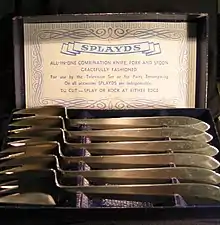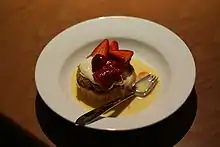

A splayd is an eating utensil combining the functions of spoon, knife and fork. It was invented by William McArthur in the 1940s in Sydney, New South Wales, Australia.[1] There are several manufacturers.
In addition to an overall spoon shape with four fork tines, it has two hard, flat edges on either side, suitable for cutting through soft food. They often have a geometric rather than rounded bowl, with two longitudinal folds in the metal.
The UK licensee for the manufacturing and distribution of splayds during the 1970s was Viners of Sheffield. At that time they were one of the biggest cutlery manufacturers in Great Britain.[2]
The splayd has medical uses, having been recommended as a solution for feeding difficulties following or during treatment of the arm[3] and being part of the (discontinued) Selectagrip system of utensils with customisable handles for people who have trouble using regular utensils.[4][5] It was also reportedly a popular wedding gift in Australia in the 1950s and 1960s.[6]
See also
References
- ↑ Mackenzie, Michael (2013-04-20). "Splayds - our national shame". Australian Broadcasting Corporation. Retrieved 24 October 2018.
- ↑ Tweedale, G. (1996). The Sheffield Knife Book. Sheffield Hallamshire Press. ISBN 9781874718116.
- ↑ Penrose, Dina (1993). Occupational Therapy for Orthopaedic Conditions. Therapy in Practice. doi:10.1007/978-1-4899-3085-9. ISBN 978-0-412-39370-9. S2CID 37256600.
- ↑ Taylor-Cookson, Judith; Mitchell, Justine (November 2001). "Cutlery for children with special needs". British Journal of Therapy and Rehabilitation. 8 (11): 426–430. doi:10.12968/bjtr.2001.8.11.13814. ISSN 1354-8581.
- ↑ "Selectagrip Cutlery And Handles". AbleData. Archived from the original on 2020-07-27. Retrieved 2020-07-27.
- ↑ Iomaire, Máirtín Mac Con (2014-07-03). "Material Culture: A Review of the 2013 Oxford Symposium on Food and Cookery". Journal of Culinary Science & Technology. 12 (3): 191–195. doi:10.1080/15428052.2014.904835. ISSN 1542-8052. S2CID 216140555.